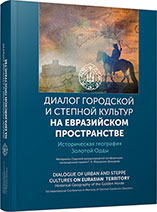Археологические признаки административных границ южносибирского средневековья (по трудам Л. Р. Кызласова)
Archaeological Features of Administrative Borders in Medieval South Siberia (after the works by L. R. Kyzlasov)
Author(s): Igor L. Kyzlasov
Subject(s): History, Archaeology, Political history, Middle Ages, 6th to 12th Centuries, 13th to 14th Centuries
Published by: Издательский дом Stratum, Университет «Высшая антропологическая школа»
Keywords: Uyghur Khaganate; Early Khakassian state; Mongol Empire; borders of possession; archaeological sites; fortresses; barrows; tamga;runic inscriptions;
Summary/Abstract: The study of archaeological and epigraphic monuments of the Middle Ages in South Siberia makes it possible to identify external (state) and internal (administrative) borders of the 8—14th-century state formations of the region. Thus, the northern boundary of the Uyghur Khaganate in the mid-8th — first quarter of the 9th century is determined by a succession of 17 similar fortresses in the mountains of Western Sayan. In the territory of the 9th—10th-century Ancient Khakassian State, the analysis of the tamga marks distribution makes it possible to fix the boundaries of the fiefdoms of six nobility clans. These data find confirmation in runic inscriptions. The expansion of the Ancient Khakassian State in the mid-9th to 10th centuries is marked by the distribution of mounds with specific rites. In the era of the Mongol Empire, urban settlements with elements of administrative and cult centers were located in the territory of Tuva within two clusters, which correspond to the two districts established by the Mongols on these lands, as confirmed by written sources.
Book: Диалог городской и степной культур на Евразийском пространстве. Историческая география Золотой Орды
- Page Range: 49-53
- Page Count: 5
- Publication Year: 2016
- Language: Russian
- Content File-PDF

